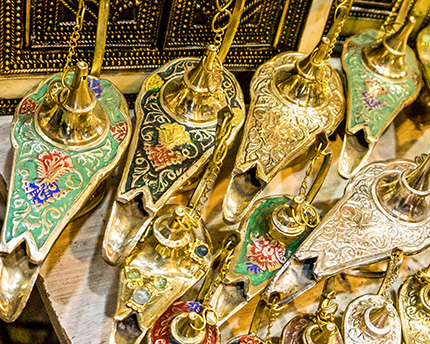There is an art to shopping in Moroccan cities and Rabat is no exception; the best places to find authentic treasures to take home with you are inside the city walls, in the Medina, but you’ll also find big shops on the city’s main thoroughfares. These days, Rabat craftspeople know how to blend tradition and modernity to cater for all preferences.
Shopping in the Medina of Rabat
The best sellers in Rabat are based in the narrow, maze-like streets of the Medina and they display their wares on stalls outside their shops to tempt passers-by. Streets in the Medina are divided by product type, like in large Arab souks, so you’ll find the leather zone, with babouche slippers, bags, wallets and colourful pouffes; the fabric zone, where embroidered kaftans hang alongside silk and cotton scarves, and linen shirts; and the spice and tea zone, full of intense, contrasting scents that mix with the aroma of cakes, a Rabat speciality that you mustn’t leave without trying.
Rue des Consuls in the Gold Souk is particularly famous.
Central Market
This enclosed building is where local farmers bring their finest produce to sell each day. It isn’t usually popular with tourists but is worth visiting to enjoy the sight of a wide assortment of colourful fruit and vegetables. You’ll also find dried fruit and nut stands here, and their variety and flavour make them one of the wonders of Morocco, plus stalls selling typical home-made confections, one of the country’s biggest culinary treats.
Rue Souika
This narrow street is always bustling with people and is the entrance to the Spice Souk, a closed-off area crammed with hundreds of stalls selling every kind of condiment you can imagine. The air is rich with the scent of cumin, cinnamon, ras el hanout, and pepper, essential spices in Moroccan food.
It’s also the perfect place to buy typical beauty products such as Kohl, which is used as an eyeliner, and henna, a traditional dye used on the hair and hands in Arab countries.
Gold Souk
This market is found on the way to the Oudayas Kasbah and is also closed off by rushes; sellers of gold, silver, and precious stones traditionally have their shops here. These tiny shops are packed with different pieces and you can sometimes see brides shopping for wedding jewellery with their mothers.
Prices are normally set based on an item’s weight, rather than the craftsmanship, so shopping here is a wonderful opportunity to buy filigree jewellery at prices that are far lower than in Europe.
Babouche Slipper Souk in Salé
This souk is in the old Medina of Salé, the city on the other side of Bou Regreg River, and it is famous for the skilled craftsmanship of its workers who make leather babouche slippers.
Countless sellers are squeezed into a small, covered space and they offer customers every possible variety of colour and model. Most have adapted this traditional footwear to the new trend of making shoes that can be worn anywhere in the world, but they still use the distinctive, Moroccan method of stitching together the leather.
Prices in Salé are fairly competitive because it isn’t a tourist-orientated city; while you are shopping you’ll be mingling with everyday customers who are visiting their local shoemaker to order the shoes they need.
















































































